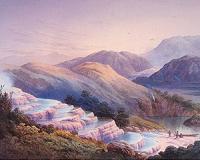 |
Washington DC (SPX) Feb 25, 2011 People who want to eat healthy and live sustainably have a new way to measure their impact on the environment: a Web-based tool that calculates an individual's "nitrogen footprint." The device was created by University of Virginia environmental scientist James N. Galloway; Allison Leach, a staff research assistant at U.Va.; and colleagues from the Netherlands and the University of Maryland. The calculator is a project of the International Nitrogen Initiative, a global network of scientists who share research and data on the nitrogen dilemma. The project was announced at the annual meeting of the American Association for the Advancement of Science in Washington. What's the nitrogen dilemma? Though some residents of the Chesapeake Bay and Gulf of Mexico likely are familiar with it, it's unknown to most Americans outside the agricultural world. For the last 30 years, Galloway and other leading scientists have been noting fish kills in coastal areas, threats to human health as a result of air and water pollution, and changes to global biodiversity and climate. This tool is one of their attempts to foster more understanding of nitrogen's role in our lives. "Nitrogen, as any farmer knows, is essential to plant life," said Galloway, associate dean for the sciences in the College of Arts and Sciences at U.Va. and the Sidman P. Poole Professor of Environmental Sciences. "But the widespread use of synthetic nitrogen fertilizer to boost crop production has resulted in excess nitrogen coming off farms - essentially adding unwanted, unneeded fertilizer to our natural systems, with disastrous results. The combustion of fossil fuels adds even more nitrogen to our environment. It's a largely untold story." Scientists are calling nitrogen pollution a major environmental problem that includes significant damage to air and water quality in places such as the Chesapeake Bay, where the federal government has dedicated hundreds of millions of dollars to reducing nitrogen runoff from farms and industry. Similarly, nitrogen runoff from Midwestern farms that ultimately flows into the Gulf of Mexico is largely responsible for toxic algal blooms that have suffocated coastal waters, leading to hypoxic zones, resulting in the loss of fish and shellfish. To raise awareness, Galloway, a pioneering nitrogen scientist, organized a global team of experts to develop the footprint calculator as an educational tool - one he and his colleagues hope will both raise the profile of the nitrogen issue and galvanize people into action. By measuring what and how much you eat, as well as other factors like how you travel, the calculator shows your impact on the nitrogen cycle. The website also makes recommendations for how to lessen your "nitrogen footprint." They are similar to other sustainable living choices: reduce airplane travel, choose renewable energy and eat less meat, particularly beef (since cattle consume massive quantities of farmed feed, which requires much fertilizer). Professors and lecturers are already using the tool in classrooms to teach students how one individual can alter - and help restore - a natural nitrogen cycle. "Solving the nitrogen dilemma is a major challenge of our time," Leach said. "By calculating our individual impact, and taking small steps to reduce it, we can all play a part - and send a strong message to our nation's leaders that we want this issue taken seriously." This new footprint calculator is the first in a series of research tools, known as N-Print, which Galloway and his team are developing to connect the production of nitrogen with the policies used to manage it. The team is currently creating a similar calculator for farmers and other nitrogen users, as well as a tool for policymakers that will provide regional nitrogen emission ceilings, which will show how much nitrogen can be released in these regions without major negative environmental impact. "There are readily available solutions to reducing nitrogen pollution," Galloway said. "By connecting consumers, producers and policymakers, we can solve it." Chemical fertilizer use and combustion engines are the main sources of nitrogen pollution. Scientists who are recording dramatic changes to ecosystems from the U.S. to China say the disruption of the naturally occurring cycle of nitrogen through ecosystems due to human activity leads the list of global tipping points and have named it a top threat to global biodiversity. It contributes to human health problems, water pollution, ozone layer depletion, smog, climate change and coastal dead zones. Nitrous oxide, created mostly from grain and meat production, is also a greenhouse gas 300 times more potent than carbon dioxide. This project is supported by the Agouron Institute, the U.S. Environmental Protection Agency, U.Va., and the Energy Research Center of the Netherlands.
Share This Article With Planet Earth
Related Links University of Virginia Dirt, rocks and all the stuff we stand on firmly
 Scientists Find Part Of New Zealand's Submerged "Pink Terraces"
Scientists Find Part Of New Zealand's Submerged "Pink Terraces"Woods Hole MA (SPX) Feb 08, 2011 They were called the Eighth Wonder of the World. Until the late 19th century, New Zealand's Pink and White Terraces along Lake Rotomahana on the North Island, attracted tourists from around the world, interested in seeing the beautiful natural formations created by a large geothermal system. But the eruption of Mt. Tarawera on June 10, 1886, buried the terraces in sediment and caused the l ... read more |
|
| The content herein, unless otherwise known to be public domain, are Copyright 1995-2010 - SpaceDaily. AFP and UPI Wire Stories are copyright Agence France-Presse and United Press International. ESA Portal Reports are copyright European Space Agency. All NASA sourced material is public domain. Additional copyrights may apply in whole or part to other bona fide parties. Advertising does not imply endorsement,agreement or approval of any opinions, statements or information provided by SpaceDaily on any Web page published or hosted by SpaceDaily. Privacy Statement |